Dear LYWA friends and supporters,
July 31st is the Buddhist holy day of Chökor Duchen, or Wheel-Turning Day, commemorating the day on which the Buddha gave his first teaching at Deer Park in India on the Four Noble Truths: the truth of suffering, the cause of suffering, the cessation of suffering and the path to the cessation of suffering. You can read a commentary by His Holiness the Dalai Lama on the Four Noble Truths.
On this auspicious day we also celebrate International Sangha Day, a time when we rejoice in the merits of the FPMT monks and nuns around the globe who are living in the vows and are guiding many on the path to enlightenment by their example.
Special Appeal: Support Our Book Printing Fund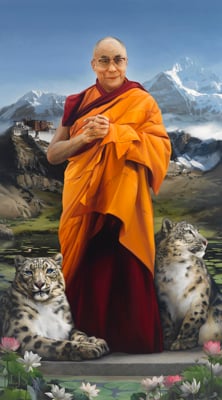 Chökor Duchen, like the other great Buddhist holidays, is a very auspicious time for merit accumulation. As cited by Lama Zopa Rinpoche from the Vinaya text Treasure of Quotations and Logic, the karmic power of all actions done on the anniversary of these events is multiplied by one hundred million. We invite you to support the Lama Yeshe Wisdom Archive during this meritorious time.
Chökor Duchen, like the other great Buddhist holidays, is a very auspicious time for merit accumulation. As cited by Lama Zopa Rinpoche from the Vinaya text Treasure of Quotations and Logic, the karmic power of all actions done on the anniversary of these events is multiplied by one hundred million. We invite you to support the Lama Yeshe Wisdom Archive during this meritorious time.
Your support at any level is always very much appreciated. For those who can offer US$1,500 or more, we will send you a very special gift. As many of you have seen, our friend Lisa Sawlit painted a spectacular portrait of His Holiness the Dalai Lama, and over the past year or so she has kindly allowed us to send prints of the portrait to LYWA supporters. Recently, she produced a limited edition of large-sized prints, 36” x 22” (91.5 x 56 cm.) in size, which have been numbered, signed and sealed by the artist. The print was appraised by a Newbury Street art dealer at $1,500. [Please note: As of 2020, the portrait is no longer available.]
Your US$1,500 will also allow you to become a Member of LYWA, with all the associated benefits, such as access to the entire LYWA library in digital format. See our Special Appeals page for more details on our book printing fund and the limited edition print.
Make your donation to LYWA today and rejoice in all the extra merit accumulated! Note that any donation made from today through the end of the week will be dedicated on this auspicious day.
What's New On Our Website
We have posted an updated version of a wonderful teaching given by Lama Zopa Rinpoche in Montana, USA in 1997 on the meaning and purpose of life, given prior to a White Tara initiation. In this teaching Rinpoche explains:
The reason for having a long life is not just for the sake of your own happiness. The actual purpose and meaning of living every day, every hour, every minute, every second is to be useful, beneficial, and to bring happiness to other beings. There are so many beings who are suffering and need your help. They need your compassion, they need your loving kindness, and they need your help and support. Whether you are helping one sentient being or many, making your everyday life beneficial and useful for them is the meaning and purpose of your life.
We have also posted advice and mantras offered by Kyabje Lama Zopa Rinpoche for healing and protection from paralysis, pollution, black magic and spirit harm. See the notes to this teaching for an extensive explanation given by Rinpoche on the term "pollution" and how to purify it.
See also a new advice from Rinpoche on Pilgrimage. This was a response from Rinpoche to a student who was going to the pilgrimage sites of Bodhgaya, Rajgir and Nalanda, India, and requested advice on practices to do at these holy places.
Check out a newly posted Russian translation of Lama Yeshe's The Essence of Tibetan Buddhism. Our website includes translations of books, teachings and prayers in 15 different languages. All of our published translations are done by experienced Dharma students and checked by other students where possible; much better than Google Translate, we promise! See the list of all translations on our site.
Ebook News and More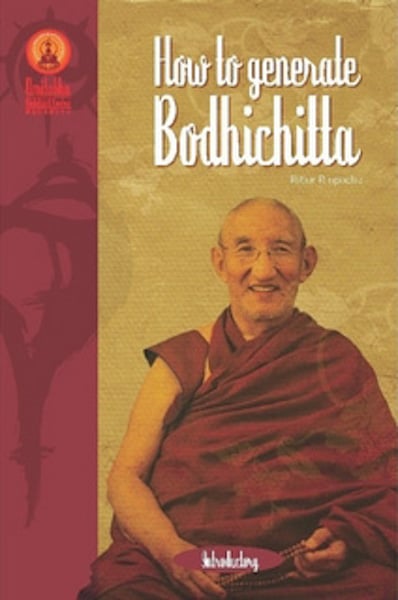 As mentioned in our last eletter, we have just published the ebook version of a book originally published by our friends at Amitabha Buddhist Center, Ribur Rinpoche's How to Generate Bodhicitta. The ebook is now available through almost all our usual ebook vendors, like Amazon, Apple, and Barnes & Noble, and the links are posted on our website. You can also read the entire text online on our companion website TeachingsFromTibet.com.
As mentioned in our last eletter, we have just published the ebook version of a book originally published by our friends at Amitabha Buddhist Center, Ribur Rinpoche's How to Generate Bodhicitta. The ebook is now available through almost all our usual ebook vendors, like Amazon, Apple, and Barnes & Noble, and the links are posted on our website. You can also read the entire text online on our companion website TeachingsFromTibet.com.
A few months ago we announced that we had published the ebook version of another ABC title, A Commentary on Praises to the Twenty-one Taras by the late Khensur Rinpoche Lama Lhundrup Rigsel. The entire text is now posted on our companion website TeachingsFromTibet.com where it can be read online.
Ebook subscription services do for ebooks what Spotify did for music and what Netflix did for film and television. With an ebook subscription service you can read as many ebooks as you like from an extensive library of titles for a flat monthly fee. You may have seen Amazon's recent announcement of the launch of their new ebook subscription service, Kindle Unlimited. Unfortunately not all Amazon titles are available through Kindle Unlimited, but no worries! You will find all LYWA titles on Scribd and Oyster, two very popular ebook subscription services already available for both iOS and Android devices.
By the way, if you have not already liked the Lama Yeshe Wisdom Archive Facebook page, please join our growing Facebook community! We know you will enjoy reading the teachings, updates and active discussions posted there daily.
New Image Gallery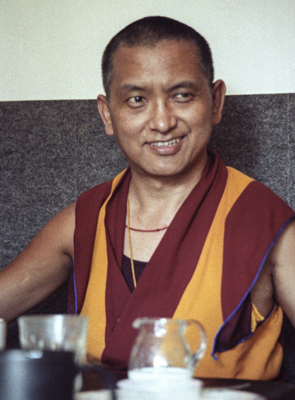 Our esteemed image editor David Zinn has recently posted a new album to our online Image Gallery of pictures of Rinpoche from 1990 and 1991. The collection includes photos from Lawudo, Nepal, 1990; Chenrezig Institute with Osel in 1991; and a series by Ueli Minder which includes the image on the right, taken in Bern, Switzerland in 1990.
Our esteemed image editor David Zinn has recently posted a new album to our online Image Gallery of pictures of Rinpoche from 1990 and 1991. The collection includes photos from Lawudo, Nepal, 1990; Chenrezig Institute with Osel in 1991; and a series by Ueli Minder which includes the image on the right, taken in Bern, Switzerland in 1990.
Our collection from these years is a bit thin, so if you have any pictures of Rinpoche from this time period please let us know.
Sangha Day 2014: Support the IMI Sangha
As mentioned above, July 31st is also the day we celebrate our precious Sangha. The International Mahayana Institute, the community of monks and nuns of the FPMT, is a crucial part of the FPMT and, as Lama Yeshe makes clear in this month’s teaching, below, extremely worthy of our support. Here at LYWA we recently donated $1,000 to the IMI to help support a monk studying at Sera-je Monastic University in south India. Please read what Lama says and do what you can. Thank you.
Much love, 
Nick Ribush
Director
This Month's Teaching: Taking Care of Our Monks and Nuns
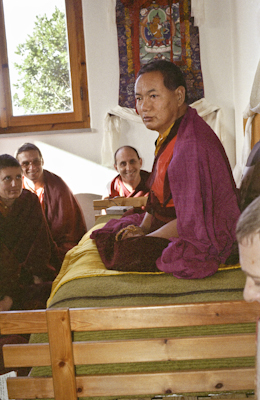 The following is an Interview with Lama Yeshe about the International Mahayana Institute (IMI), September 1983 at Istituto Lama Tzong Khapa. Click here to see more photos from this time.
The following is an Interview with Lama Yeshe about the International Mahayana Institute (IMI), September 1983 at Istituto Lama Tzong Khapa. Click here to see more photos from this time.
Q. What is IMI’s relationship to the FPMT?
Lama Yeshe: The monks and nuns of the IMI are all FPMT students. In fact, the IMI started before the FPMT came into existence. Therefore, as an organization, the FPMT has to help its monks and nuns. We have to facilitate their education, offer spiritual and material help, and in general assist them as much as we can. We have to bring them teachers, translators, other necessary resources and whatever else they need. The Foundation is responsible for everything. We are raising this baby; it’s our baby. The Sangha cannot exist without our help. They cannot help themselves. What happens is that we give them a certain amount of help for a while but then they come down. So we help bring them up but then they come down again. You can see how it’s been; they’ve been up and down a lot over the past ten years. The Sangha are like a baby—a baby needs a mother to take of it. Our baby cannot exist alone. It’s not possible; they’re not strong enough.
If somebody says the Sangha should take care of themselves, you should ask them how. The IMI organization is still in its infancy; it can’t exist by itself. If we just do nothing it will die tomorrow. We have to water it, fertilize it and give it constant attention.
It’s the same with our centers, our Western baby centers. They need an incredible input of energy. We also have to watch them as we watch a baby. My experience has been that I visit one year and bring them up a little, but when I return the following year they’ve already hit bottom again. So that’s all the evidence we need. I’m not saying I’m such a great person. This is just the way it is.
So both IMI and the new centers need to be babysat. That’s the reason I run around the world all the time. I’m babysitting. It’s not that I’m an important person; I’m just a babysitter. They come down, cry and I say, “Hey, hey, come on, come on, come on.” I bring them up a little and then say “Goodbye.” Next time I come they’ve again hit bottom. Can you imagine? All right. That’s the situation as it has been so far; hopefully after another twenty years they’ll be able to run by themselves. Then they can say, “OK, we don’t need any more help.” Right now they need help.
Well, I tell you, I have more reasons. First of all, our centers are part of a new culture, a new constitution, a new society. This creates a lot of confusion. They can’t identify themselves, so they’re always confused. I understand. Sometimes they have the strong projection that “We’re special.” I say, “No, you’re not special.” I have to say that; put them down. Sometimes they say, “We’re nobody; we can’t exist.” Then I have to say, “Yes, we can exist.” It’s very funny! Phew! I have to go through this kind of thing all the time. Maybe you now have some compassion for me! You’ve discovered my life.
So, what I’m saying about the centers also applies to the IMI.
Q. What does it mean to be a member of the IMI?
Lama Yeshe: Any monk or nun who takes or utilizes our energy is a member of the IMI. That’s all; it’s so simple. Whoever uses our facilities is a member of the IMI.
Q. What are the benefits of joining the IMI rather than staying independent as a monk or a nun?
Lama Yeshe: That depends on the individual. Some need to be cared for like a baby; we take care of them. Some are capable of remaining on their own with nobody taking care. That’s their freedom. What can I say? But we can see clean clear that we need to babysit most of the Sangha. That’s why we currently have about forty monks and forty nuns. If we hadn’t babysat them they’d have all been finished within a year. I’m not ego-tripping; this is based on evidence.
Q. Does the IMI have responsibility to the FPMT?
Lama Yeshe: Of course. That’s not really a question that needs to be asked! If the Foundation supports them spiritually and materially they have a great responsibility to the organization. Forget about their worldly responsibilities, if they are following ethics correctly, their first requirement is to keep their karma straight. If somebody supports and takes care of them, they should have some understanding of their karmic obligation to repay that kindness.
Q. Lama, we have very few models to follow as monks and nuns, and as yet we have no well-established monasteries. It’s not easy to be a monk and nun in the twentieth century. Do you have any suggestions or advice for people who are considering ordination?
Lama Yeshe: Well, in my experience, it’s a good idea that prospective Sangha understand what it means to be a monk or nun. They need clean clear instruction in this before they get ordained. Also, being a monk or nun is just an idea, a concept. Living the life of a monk or nun is something else. So, what I like to do is give students a gradual experience of living in ordination.
After new students take refuge we offer them the five lay precepts and the twenty-four-hour Eight Mahayana Precepts as well. If they observe them well, they get some experience of living in ordination. Then, if they would like to go further, we give the renunciation ordination (Tib: rab-jung). Here you need to follow the advice of your abbot or preceptor obediently and get his advice on the major decisions of your life; live in a monastery and behave as a monk or nun; and not act as a layperson, following desire, wearing all kinds of different clothes and so forth. These are the three things of which you have to be aware.
When you are comfortable with all that, you’re ready to take the thirty-six novice vows. And if over a period of time you observe them well, you can take the full ordination of a monk or nun. So that’s a much better way to proceed rather than just jumping straight in without any experience of keeping vows.
Then, of course, I highly recommend that new Sangha live in a monastery. I tell you, for monks and nuns, life in a monastery is like life in the ocean for a fish—the water protects you and out of it you die. It’s absolutely the same thing for monks and nuns. If you live in a monastic community, really observing your precepts, it’s blissful. Following the rules is blissful. The monastic rules were made with compassion and living the ethical life brings you peaceful tranquility, so it really is a blissful life. Otherwise, I agree with you: not living in a monastic community makes it very difficult for twentieth century monks and nuns to survive. That’s why we’re trying so hard to establish Sangha communities.
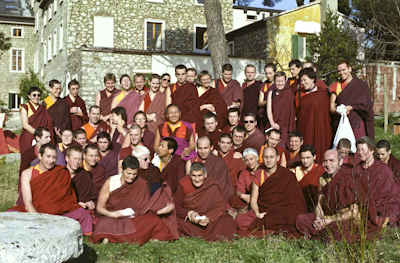 Q. Lama, can you please say just a little more about the value of having monastic communities and continuing the tradition of monastic life in the twentieth century.
Q. Lama, can you please say just a little more about the value of having monastic communities and continuing the tradition of monastic life in the twentieth century.
Lama Yeshe: Well, as I say, it’s very, very useful. But some people have the misconception that Buddhist monasteries are like Christian ones. Many Christian monks remain in their monasteries for life and never come out into society. This is not what happens in Buddhist monasteries. Our point of view is that you stay in the monastery for as long as it takes you to get healthy and then, when you’re strong enough, educated and free from confusion, you go out and teach. You get involved with society. I don’t see Western Buddhism monks and nuns spending their whole life in a monastery and dying in there. That’s not the point.
Q. What’s the most helpful relationship that the Sangha can have with the lay community for their mutual benefit?
That’s simple. Sometimes Sangha can lead meditation courses. There’s mutual benefit right there. They assist in each other’s spiritual growth and Dharma education. That’s good enough. But one important thing is that laypeople and Sangha should respect each other’s individual rights and needs. Laypeople shouldn’t say, “I don’t understand why you need to be a monk,” putting it down in an ego-trip sort of way. They should understand why people get ordained; that it’s their choice and something that laypeople cannot do themselves. They should rejoice in and respect that choice. “Well, it’s something I can’t do. Just that they’re trying is good enough. At least they’re trying.”
Of course, it’s no good if monks and nuns can’t maintain their reality any better than that of laypeople. Then the laity should criticize them: “You’re no better than us. Why did you get ordained?” That’s a good thing to criticize. “We understand how you’re supposed to be. We’re not stupid. We’ve studied the lamrim; we’ve studied the Vinaya. You should act according to your vows, otherwise you make us ashamed of you.” Laypeople can criticize in that way and are right to do so.
But at the same time they should have respect for the Sangha and try to understand the difficulties they go through. “They mean well and they do work hard.” They should have sympathy for their ordained colleagues and support them as much as they can. Similarly, monks and nuns should not have the egotistic attitude, “We’re better; laypeople are lower than us.” That’s not true. We’re deluded; they’re deluded. The difference is that we try to control our delusions a little bit; we try to stop them from manifesting. Even though our mind wants them to manifest, we try not to let them. That is what we do, isn’t it? We should be honest: we have problems, but we try to stop them from manifesting, as painful as it might be to control them. We try hard not to eat chocolate!
So, we need to understand laypeople and they need to understand us. It’s important that we understand and not ego-trip each other. Mutual respect is very useful.
Still, I have to say that, in my observation, monks and nuns are a very good investment in the future of the complete Dharma coming into the Western world. Dharma is something you have to live. It is so vast, so universal, that you have to live it. Then you become Dharma and that’s the true sense of bringing Dharma to the West. If you don’t live it and your knowledge is merely intellectual philosophy, you can’t call that bringing Dharma to the West.
Therefore, if the Dharma we’re transmitting becomes organic in this way, I think we’ll be successful. So again, without intensive practice and living a Dharma life, it’s not possible to bring Dharma to the West. As I see it, it’s important that we have a Sangha organization within our FPMT society and we’re lucky that we do. So we have to take care of our monks and nuns.
However, within our society, we have a crisis when it comes to the support of our IMI Sangha. This is the most important thing. At this present time, at the moment, the most important issue facing us is how to take care of our monks and nuns and how to establish successful monasteries. We have reached a very important point in terms of the peace movement and the world situation. I really want our Dharma center family to understand this.
Up to now they have been very generous in supporting the Eastern Sangha over the past ten years. They have been very good in supporting various Eastern Sangha projects and giving them money, but now, by comparison, the Western Sangha is destitute. They don’t even have bread and butter; they’re worse off than refugees. It seems to me very odd that we don’t take better care of them than we do.
So I’m very humbly asking our Western Dharma establishment to consider paying attention to and supporting the IMI Sangha as generously as possible. You know that for many years I have campaigned for the support of my children, the monks of Kopan’s Mt. Everest Centre, but now I’ve even asked some of my children’s benefactors to support my Western Sangha instead. They need the help and, as I said, it’s a good investment. As you know, we have a shortage of teachers in the FPMT and we can’t rely on Eastern teachers all the time. We should be self-sufficient and not dependent upon Eastern monks. So the way to self-sufficiency is for our Western Sangha to be fully educated and to transform themselves into professional Dharma teachers. And for that we need financial support.
Q. Some Western Sangha feel that they should study and teach only what they call pure Dharma, the teachings that they receive from the Tibetan lamas and geshes, and are reluctant to get involved in Universal Education, the universal Dharma that’s in the new language. They don’t want to study and try to prepare this form of Dharma, because they want to be pure and traditional. Could you comment on this?
Lama Yeshe: Well, that’s an interesting question. First of all, my style is for the Western Buddhist path not to become a Tibet trip. That’s totally wrong. So Western monastics should not have the attitude, “I have to live purely, therefore I should not work.” That logic is faulty. In fact, Sangha should work harder than laypeople in the sense that they should be more active, not lazy and sluggish. They should study and dedicate themselves to serving others in whatever way they can. Whenever there’s a situation where they can help others, they should work to do so. They should not adopt a sluggish lifestyle, rationalizing, “I’m pure, I don’t need to work.” Pure is one thing; bread and butter is something else.
I agree with you. Be practical. From the side of the Sangha, they need to be practical and ready to face any difficulties that might arise. From the other side, from the side of the laypeople, they should be sympathetic. They have their karma and the monks and nuns have theirs, which they need to keep straight.
It’s like children. The parents take care of their children and then the children don’t do anything to return their parents’ kindness. That’s too bad, isn’t it? It’s the same with the Sangha. They should have the dedicated attitude to face any situation that gives them the opportunity of improving themselves and not be lazy, giving the excuse, “I’m pure, I cannot work. I don’t wash dishes.” Wrong. I wash my own dishes; I can cook. I cooked for my teacher and myself for twenty-five years and studied at the same time. That doesn’t mean they’re pure; that means they’re lazy. The Sangha should not be that way.
I’ve also told my Sangha community that we should not expect laypeople to support us “because we’re pure.” That’s the wrong attitude. In this twentieth century we should be self-sufficient. We can be if we want to be. We should be able to take care of ourselves physically and mentally. It’s our responsibility to do so and I’ve told the monks at Nalanda Monastery that they should be self-sufficient—they should use their brain, work with their hands and support themselves.
Q. Traditional teachers use words such as Dharma, karma and so forth. Now we have some translators who use a different language, which seems to be similar to the concept of universal education that you have talked about. To what extent should the Western Sangha also teach using the new Western language instead of traditional Sanskrit words.
Lama Yeshe: That’s a good idea. When you speak in a person’s language, obstacles and excuses disappear. People are very attached to their own culture, so when you use terminology from another one, they can feel that what you’re saying doesn’t apply to them: “What? Karuna? That’s Sanskrit. He’s using too much foreign terminology.” Our ego very much identifies with its own culture. So although there can be exceptions, when trying to communicate Dharma, it’s good to use words to which the audience can relate.
Some students have told me that although they had taken many teachings from Tibetan lamas, it was only when they heard it from a Western teacher that they really understood the Dharma. Before, it had some kind of artificial cover, so they just left it: “This Tibetan monk is just talking about Tibetan culture. I don’t care for what he’s saying, he’s too different from me.” They make the excuse of cultural distinction. But when they hear teachings in their own language, they’re suddenly touched. “What? This Westerner is speaking my language. She’s shaking my heart.” They’re touched by Dharma. Then there’s no way out!
Edited from the Lama Yeshe Wisdom Archive by LYWA director Nicholas Ribush. He was the first director of the IMI (1973–75) and a monk for twelve years. Also see Advice for Monks and Nuns where Lama Yeshe and Lama Zopa Rinpoche explain the great benefits of practicing Dharma as an ordained person, how to keep the ordination pure, the purpose of the monastic community, how to live together as monks and nuns, and much more.































